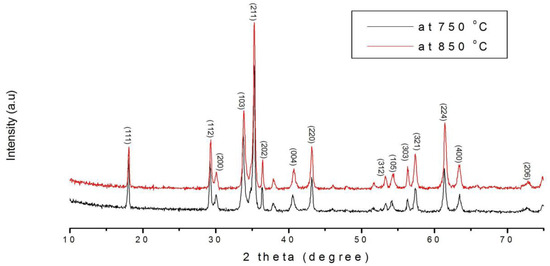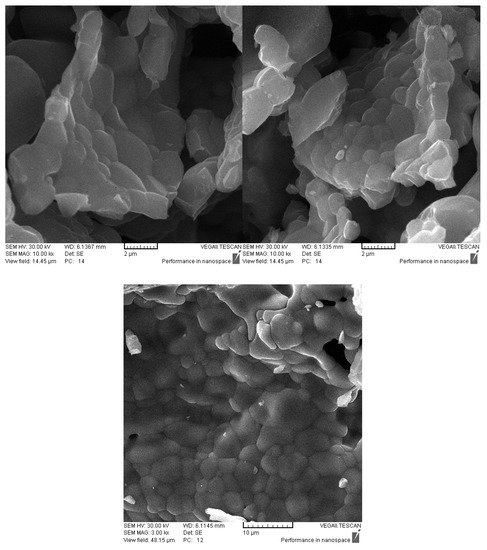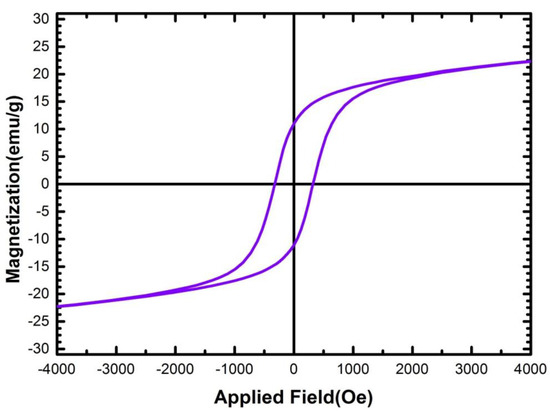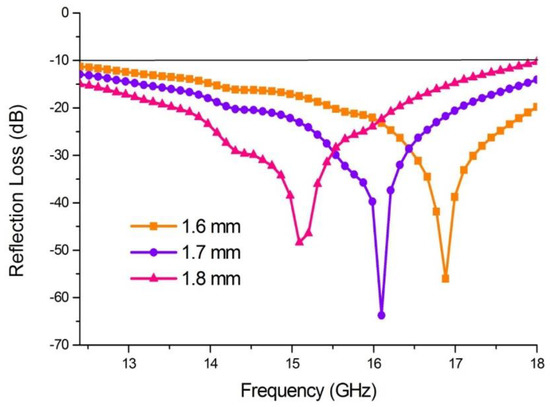Abstract
Recently, using microwave devices that emit electromagnetic waves and enhance the convenience of life have increased; however, they can be harmful to the environment. In this study, CuFe2O4 nanoparticles were prepared through the conventional sol-gel procedure and then were characterized by X-ray powder diffraction (XRD), vibrating sample magnetometer (VSM), field emission scanning electron microscopy (FE-SEM), Fourier transform infrared spectroscopy (FT-IR), and vector network analyzer (VNA) using S parameters. Results illustrated that pure crystal structure of magnetic nanoparticles has been synthesized by the sol-gel method with magnetic saturation (Ms) of 22 emu/g. Finally, CuFe2O4 nanoparticles were composited by silicone rubber to investigate its microwave absorption properties. Results showed that the CuFe2O4/silicone rubber nanocomposite absorbed more than 94.87% of the microwave irradiation at ku-band frequency with 1.7 mm thickness and the maximum reflection loss was −60.38 dB at 16.1 GHz. Magnetic and dielectric properties of the CuFe2O4 nanoparticles and silicone rubber polymeric matrix in the nanocomposite demonstrated desirable microwave absorption properties.
1. Introduction
CuFe2O4 nanoparticles have attracted substantial attention because of their various applications in photocatalysts, sensors, water treatment catalysts, and air purification systems [1,2]. Microemulsion, thermal decomposition, aerosol, co-precipitation, mechanochemical, and hydrothermal methods have been used to synthesize spinel nanoparticles [3,4,5,6,7]. In the last decade, the microwave absorption capability of materials has been widely investigated due to various applications of microwave absorbing materials in the electric industries. Impedance matching, permittivity, and permeability are the most important factors affecting the microwave attenuation given by transmission line theory [8,9,10]. To improve impedance matching, various chemical and physical methods have been employed to merge magnetic and dielectric features of the components led to more microwave absorption [7,11,12]. The CuFe2O4 spinel structure is the potential candidate for microwave devices because it has shown acceptable magnetic and dielectric properties at high frequency [13,14]. In this research CuFe2O4 nanoparticles were prepared using the sol-gel method. Subsequently, the microwave absorption properties of the nanoparticles were investigated using silicone rubber medium.
2. Experimental
2.1. Materials and Instruments
Cu (NO3)2·3H2O, iron (III) nitrate nonahydrate, citric acid, and ammonia solution were purchased from Merck. To prepare the microwave absorbing nanocomposite, silicone rubber was obtained from ELASTOSIL® M4503. Wacker RTV-2.
The chemical functional groups were revealed by Shimadzu 8400 S Fourier transform infrared (FT-IR). Scanning electron microscope (SEM) images of the nanoparticles were obtained using Tescan Mira2. IRI Kashan vibrating sample magnetometer (VSM) presents the magnetic properties of sample. The crystal structure of the nanoparticles was explored by Philips X’Pert MPD instrument. Finally, Agilent technologies, E8364A exhibited microwave absorption properties.
2.2. Synthesis of CuFe2O4 Nanoparticles
To prepare of CuFe2O4 nanoparticles by the sol-gel method, stoichiometric amount of nitrate salts and citric acid were dissolved in distilled water. Then, alkaline pH was adjusted by ammonia solution. After that, a wet gel was obtained by maintaining the solution at 90 °C and then the gel was calcined at 750 and 850 °C for 4 h to compare the results.
2.3. Preparation of Microwave Absorbing Composite
The CuFe2O4 nanoparticles were added to silicone resin and then was molded to investigate microwave absorption properties using hardener with 20 wt. %.
3. Results and Discussions
3.1. Phase Identification Analysis
The X-ray powder diffraction (XRD) patterns of the CuFe2O4 nanoparticles calcined at 750 °C and 850 °C have been shown in Figure 1. As shown in the patterns, all angles of the crystal planes are corresponded to the [034-0425] standard cart with any impurities of crystal phase. The crystal size of nanoparticles calculated 15.6 nm based on the Scherrer equation.

Figure 1.
X-ray powder diffraction (XRD) patterns of CuFe2O4 nanoparticles calcined at 750 °C and 850 °C.
3.2. Morphology
The morphology of CuFe2O4 nanostructures prepared at 850 °C was investigated by SEM analysis. SEM micrographs confirmed that the structure, size, and shape of CuFe2O4 nanoparticles were the same (Figure 2).

Figure 2.
Field emission scanning electron microscopy (FE-SEM) images of CuFe2O4 nanoparticles calcined at 850 °C.
3.3. FT-IR Spectroscopy
FT-IR was used to determine the structure and investigation of the chemical species. According to the result showed in Figure 3, broad band peaks at 417.74, 577.38, and 1200 cm−1 are related to metal-oxide stretching vibrations of the octahedral, tetrahedral, and hexagonal sites in crystalline structures, respectively. The peak at 1639.12 cm−1 and broad band peak at 3440.80 cm−1 are assigned to the bending and stretching vibration of O–H related to the adsorbed water.

Figure 3.
Fourier transform infrared (FT-IR) spectrum of CuFe2O4 nanoparticles calcined at 850 °C.
3.4. Magnetic Properties
The magnetic properties obtained in room temperature using VSM instrument operating with frequency of 25 Hz and −4 < kOe < 4 applied field. Figure 4 shows the hysteresis loop of the CuFe2O4 nanoparticles calcined at 850 °C. According to the results, saturation magnetization, remnant magnetization, and coercivity were 22 emu/g, 10 emu/g, and 325 Oe, respectively.

Figure 4.
The hysteresis loop of CuFe2O4 nanoparticles calcined at 850 °C.
3.5. Microwave Characteristics
The Microwave absorption properties of CuFe2O4 nanoparticles were revealed using a silicone rubber medium. Figure 5 presents the reflection losses of CuFe2O4/silicone rubber nanocomposite at different thicknesses. The results showed that CuFe2O4/silicone rubber nanocomposite absorbed more than 94.87% of microwave irradiation along the ku-band frequency with 1.7 mm thickness while the maximum reflection loss was −60.38 dB at 16.1 GHz originated from suitable impedance matching, eddy current loss, magnetic resonance, conductive loss, electron migrating, as well as interfacial polarization.

Figure 5.
The microwave absorption properties of CuFe2O4/silicone rubber nanocomposite at different thicknesses.
4. Conclusions
It can be concluded that pure CuFe2O4 nanoparticles have been prepared using conventional and simple sol-gel method. XRD patterns confirmed that pure crystal structure of CuFe2O4 nanoparticles were synthesized having a size of 15.6 nm. The uniform morphology of CuFe2O4 nanostructures were confirmed by SEM images. The FT-IR result showed that nanoparticles were completely calcined after the heat treatments. According to the results, the CuFe2O4/silicone rubber nanocomposite demonstrated considerable microwave absorption properties due to proper magnetic, dielectric, and impedance matching characteristics.
References
- Rus, S.; Vlazan, P.; Novaconi, S.; Sfirloaga, P.; Grozescu, I. Synthesis and characterization CuFe2O4 nanoparticles prepared by the hydrothermal ultrasonic assisted method. J. Optoelectron. Adv. Mater. 2012, 14, 293. [Google Scholar]
- Amraei, B.; Rezaei Kalantary, R.; Jonidi Jafari, A.; Gholami, M. Efficiency of CuFe2O4 Bimetallic in Removing Amoxicillin from Aqueous Solutions. J. Mazandaran Univ. Med. Sci. 2017, 27, 259–275. [Google Scholar]
- Maleki, A.; Ghalavand, R.; Firouzi Haji, R. Synthesis and characterization of the novel diamine-functionalized Fe3O4@SiO2 nanocatalyst and its application for one-pot three-component synthesis of chromenes. Appl. Organomet. Chem. 2018, 32, e3916. [Google Scholar] [CrossRef]
- Tadjarodi, A.; Abbaszadeh, A. A magnetic nanocomposite prepared from chelator-modified magnetite (Fe3O4) and HKUST-1 (MOF-199) for separation and preconcentration of mercury (II). Microchim. Acta 2016, 183, 1391–1399. [Google Scholar] [CrossRef]
- Pourjavadi, A.; Doroudian, M.; Saveh, Z.A.; Doulabi, M. Synthesis of new electromagnetic nanocomposite based on modified Fe3O4 nanoparticles with enhanced magnetic, conductive, and catalytic properties. Int. J. Polym. Mater. Polym. Biomater. 2016, 65, 384–390. [Google Scholar] [CrossRef]
- Lemine, O.; Bououdina, M.; Sajieddine, M.; Al-Saie, A.; Shafi, M.; Khatab, A.; Al-Hilali, M.; Henini, M. Synthesis, structural, magnetic and optical properties of nanocrystalline ZnFe2O4. Phys. B Condens. Matter 2011, 406, 1989–1994. [Google Scholar] [CrossRef]
- Peymanfar, R.; Javanshir, S.; Naimi-Jamal, M.R. Preparation and characterization of MWCNT/Zn0.25Co0.75Fe2O4 nanocomposite and investigation of its microwave absorption properties at x-band by silicone rubber polymeric matrix. In Proceedings of the 21st International Electronic Conference on Synthetic Organic Chemistry, 1–30 November 2017, Santiago, Spain.
- Moitra, D.; Dhole, S.; Ghosh, B.K.; Chandel, M.; Jani, R.K.; Patra, M.K.; Vadera, S.R.; Ghosh, N.N. Synthesis and Microwave Absorption Properties of BiFeO3 Nanowire-RGO Nanocomposite and First-Principles Calculations for Insight of Electromagnetic Properties and Electronic Structures. J. Phys. Chem. C 2017, 121, 21290–21304. [Google Scholar] [CrossRef]
- Wang, X.-X.; Ma, T.; Shu, J.-C.; Cao, M.-S. Confinedly tailoring Fe3O4 clusters-NG to tune electromagnetic parameters and microwave absorption with broadened bandwidth. Chem. Eng. J. 2018, 332, 321–330. [Google Scholar] [CrossRef]
- Afghahi, S.S.S.; Peymanfar, R.; Javanshir, S.; Atassi, Y.; Jafarian, M. Synthesis, characterization and microwave characteristics of ternary nanocomposite of MWCNTs/doped Sr-hexaferrite/PANI. J. Magn. Magn. Mater. 2017, 423, 152–157. [Google Scholar] [CrossRef]
- Mallick, A.; Mahapatra, A.; Mitra, A.; Chakrabarti, P. Soft magnetic property and enhanced microwave absorption of nanoparticles of Co0.5Zn0.5Fe2O4 incorporated in MWCNT. J. Magn. Magn. Mater. 2016, 416, 181–187. [Google Scholar] [CrossRef]
- Peymanfar, R.; Javidan, A.; Javanshir, S. Preparation and investigation of structural, magnetic, and microwave absorption properties of aluminum-doped strontium ferrite/MWCNT/polyaniline nanocomposite at KU-band frequency. J. Appl. Polym. Sci. 2017, 134, 45135. [Google Scholar] [CrossRef]
- Ali, K.; Iqbal, J.; Jan, T.; Ahmad, I.; Wan, D.; Bahadur, A.; Iqbal, S. Synthesis of CuFe2O4-ZnO nanocomposites with enhanced electromagnetic wave absorption properties. J. Alloys Compd. 2017, 705, 559–565. [Google Scholar] [CrossRef]
- Ali, K.; Iqbal, J.; Jana, T.; Ahmad, N.; Ahmad, I.; Wan, D. Enhancement of microwaves absorption properties of CuFe2O4 magnetic nanoparticles embedded in MgO matrix. J. Alloys Compd. 2017, 696, 711–717. [Google Scholar] [CrossRef]
Publisher’s Note: MDPI stays neutral with regard to jurisdictional claims in published maps and institutional affiliations. |
© 2018 by the authors. Licensee MDPI, Basel, Switzerland. This article is an open access article distributed under the terms and conditions of the Creative Commons Attribution (CC BY) license (https://creativecommons.org/licenses/by/4.0/).